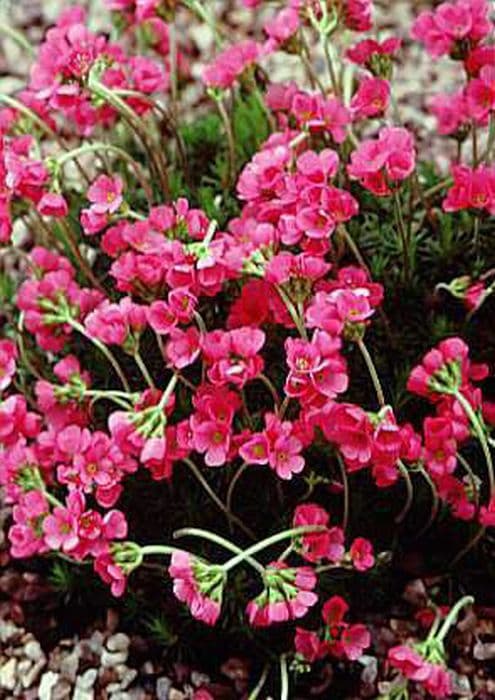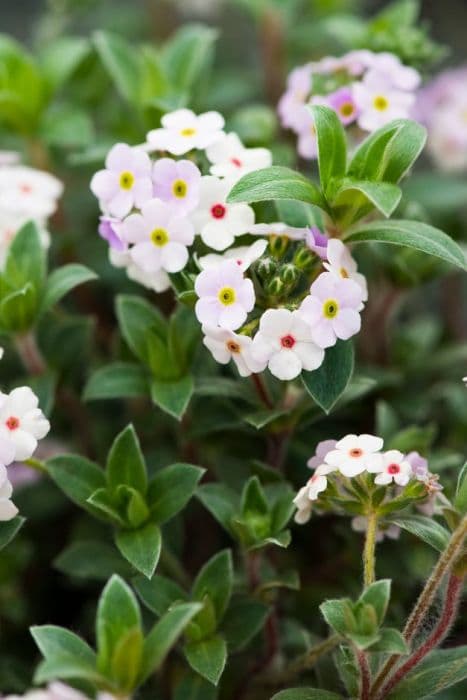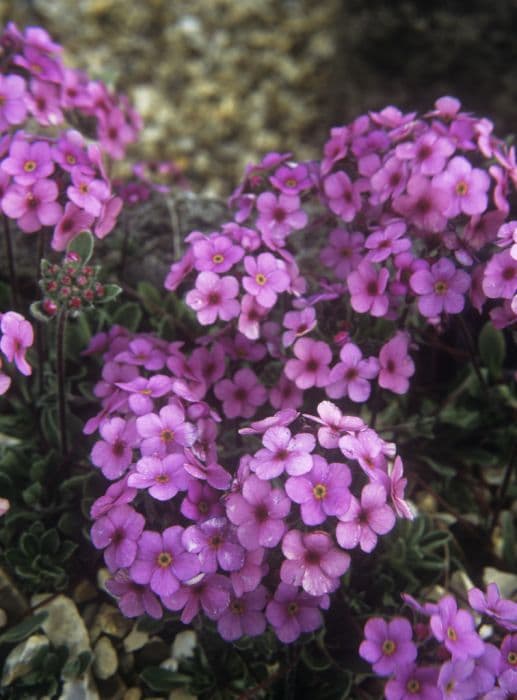Japanese Primrose Primula sieboldii 'Daiminnishiki' (Co)

ABOUT
Primula sieboldii 'Daiminnishiki,' commonly known as Siebold's primrose, is a striking perennial plant known for its elegant and colorful appearance. The plant features a lush rosette of green leaves that provide a rich backdrop for its most prominent feature, the flowers. These blossoms present a vivid display, with petals that exhibit shades of pink, marked with bursts of white creating a captivating contrast. The flowers have a ruffled look with intricate edges, imparting a sense of delicacy to the overall aesthetic of the plant. The leaves of Siebold's primrose are typically rounded with a slightly toothed edge, contributing to the texture of the plant. The deep green of the foliage often has a lustrous sheen, making it an attractive element even when the plant is not in bloom. The blossoms of 'Daiminnishiki' are supported by slender stalks that rise from the base, allowing the flowers to hover gracefully above the foliage like a cloud of color. The overall impression of Primula sieboldii 'Daiminnishiki' is one of vibrancy and charm, making it a beloved addition to gardens where it can be admired during its flowering period.
About this plant
 Names
NamesSynonyms
Siebold's Primrose, Japanese Primrose, Geisha Girl
Common names
Primula sieboldii 'Daiminnishiki'
 Toxicity
ToxicityTo humans
Primula sieboldii, commonly known as Japanese Primrose, is not listed as a toxic plant to humans. There are no known toxic principles in this species that would cause harm from ingesting. However, as with any plant, individual allergies or sensitivities could potentially cause mild discomfort or reactions, but general toxicity leading to serious health consequences is not recognized for Japanese Primrose.
To pets
Japanese Primrose is not typically considered toxic to pets. It is not listed among commonly recognized toxic plants for dogs, cats, or other domestic animals. There should be no significant risk of poisoning from ingesting parts of this plant. However, as with any non-food plant, ingestion could potentially cause mild gastrointestinal upset, such as vomiting or diarrhea, due to the animal's digestive system not being accustomed to processing plant material of this kind. It is always best to discourage pets from eating plants not meant for their consumption to avoid any potential issues.
 Characteristics
CharacteristicsLife cycle
Perennials
Foliage type
Deciduous
Color of leaves
Green
Flower color
Mixed
Height
0.5 feet (15 centimeters)
Spread
0.5 feet (15 centimeters)
Plant type
Herb
Hardiness zones
4
Native area
Asia
Benefits
 General Benefits
General Benefits- Enhances Garden Aesthetics: Primula sieboldii 'Daiminnishiki' features beautiful variegated leaves and vibrant blooms that add visual interest and beauty to gardens and landscapes.
- Attracts Pollinators: The flowers provide a nectar source for bees, butterflies, and other beneficial pollinators, supporting local ecosystems.
- Low Maintenance: Known for its resilience and low care requirements, making it an ideal choice for novice gardeners or those with limited time for garden upkeep.
- Drought Tolerant: Once established, this plant is relatively drought-tolerant, reducing the need for frequent watering and thus conserving water resources.
- Seasonal Interest: Offers rich seasonal colors, with blooming in late spring to early summer, providing a seasonal focal point in the garden.
- Cold Hardy: Possess strong cold tolerance, allowing it to thrive in cooler climates and survive frosty conditions.
- Ground Cover: Can serve as an effective ground cover when planted in groups, helping to prevent soil erosion and suppress weed growth.
- Container Gardening: Suitable for container gardening, allowing those with limited garden space, such as balconies or patios, to enjoy its beauty.
- Edging Plants: Due to its compact size, it serves well as an edging plant along paths or garden borders, creating defined lines and structure.
 Medical Properties
Medical PropertiesThis plant is not used for medical purposes.
 Air-purifying Qualities
Air-purifying QualitiesThis plant is not specifically known for air purifying qualities.
 Other Uses
Other Uses- Primula sieboldii 'Daiminnishiki', commonly known as the Siebold Primrose, can be used in sugarcraft or confectionery decoration as its flowers are not only attractive but also edible, adding a touch of elegance to cakes and desserts.
- In Japan, the Siebold Primrose is incorporated into traditional "hanami" celebrations, where people enjoy the transient beauty of flowers, including viewing parties beneath the blooms.
- The plant's bright and variably patterned flowers can be used as natural dyes for fabrics, offering a range of pastel tones for textiles.
- Artists may use Siebold Primrose as a subject in botanical illustration, capturing their delicate shapes and colors on paper or canvas.
- The Siebold Primrose can inspire landscape artists in rock garden design, leveraging their ability to thrive in rocky, well-drained environments.
- These plants can be used in educational settings such as schools or botanical gardens for lessons in plant biology, specifically in discussing pollination syndromes due to their relationship with specific pollinators.
- Garden hobbyists may utilize the cross-breeding potential of Siebold Primrose to experiment with hybridization, creating new varieties with unique petal patterns and colors.
- These plants can be part of a sensory garden due to their soft foliage and bright flowers, offering a tactile and visual experience for visitors with sensory processing needs.
- In photography, the Siebold Primrose can provide an excellent, photogenic spring subject due to its appealing aesthetics and the way it reflects the change of seasons.
- The plant might also play a role in cultural education as it demonstrates the significance of flora in traditional Japanese aesthetics and the concept of 'wabi-sabi,' appreciating beauty in imperfection and transience.
Interesting Facts
 Feng Shui
Feng ShuiThe plant Siebold's Primrose is not used in Feng Shui practice.
 Zodiac Sign Compitability
Zodiac Sign CompitabilityThe plant Siebold's Primrose is not used in astrology practice.
 Plant Symbolism
Plant Symbolism- Delicacy and Sensitivity: Primula sieboldii, commonly known as the Japanese Primrose, features delicate petals which can symbolize sensitivity in emotions and relationships.
- New Beginnings: This flower typically blooms in the spring, a time often associated with new beginnings and fresh starts, making it a symbol of rebirth and renewal.
- Hope: The bright colors of the Japanese Primrose can represent hope and positive expectations; it's a flower that blooms after winter, signifying the promise of better things to come.
- Young Love: The Japanese Primrose is often connected to feelings of young love, possibly due to its gentle appearance and association with spring – the season of love.
- Longevity and Persistence: Primula sieboldii is a perennial plant, which means it can live for several years. It symbolizes long-lasting life and enduring nature.
 Water
WaterThe Japanese Primrose should be watered deeply but infrequently, allowing the soil to slightly dry out between waterings. Ideally, water it with about one gallon per plant every week during the growing season, adjusting for rainfall and temperature. Increase the frequency to approximately twice per week during hot, dry periods, but be cautious not to overwater as this can lead to root rot. During the winter, reduce watering as the plant goes dormant, providing enough to keep the soil from completely drying out, which may be as little as one gallon every two to three weeks depending on indoor conditions.
 Light
LightThe Japanese Primrose prefers bright, indirect light or partial shade. It thrives best when protected from the harsh afternoon sun, so a spot that receives filtered morning light with shade in the afternoon is ideal. Avoid deep shade as this can lead to poor flowering.
 Temperature
TemperatureThe Japanese Primrose is comfortable in a range of temperatures, with ideal growing conditions between 50 and 70 degrees Fahrenheit. It can withstand short periods of colder weather down to about 20 degrees Fahrenheit but should be protected from frost. Exposing the plant to temperatures above 80 degrees Fahrenheit for prolonged periods can be detrimental to its health.
 Pruning
PruningPruning the Japanese Primrose is mostly about removing spent flowers and dead or yellowing leaves to encourage a tidy appearance and promote new growth. The best time to prune is after flowering, cutting back the flower stalks to the base. Deadheading regularly during the blooming season can also help to stimulate more blooms.
 Cleaning
CleaningAs needed
 Soil
SoilThe best soil mix for Japanese primrose should be rich, well-draining, and have a slightly acidic pH of 6.0 to 6.5. A mix of peat, loam, and perlite or sand works well to provide the necessary drainage and nutrients.
 Repotting
RepottingJapanese primrose should be repotted every 1-2 years to replenish the soil and accommodate root growth, ideally just after flowering.
 Humidity & Misting
Humidity & MistingJapanese primrose thrives in moderate to high humidity levels, ideally around 50-60%, which helps keep the foliage healthy and supports its growth.
 Suitable locations
Suitable locationsIndoor
Place in bright, indirect light with moderate humidity.
Outdoor
Choose a shaded spot with moist soil for best growth.
Hardiness zone
4-8 USDA
 Life cycle
Life cyclePrimula sieboldii 'Daiminnishiki' (Co), commonly known as Japanese primrose, germinates from seed, with the seedlings developing true leaves and a small root system. The plant then enters a vegetative growth phase, forming a rosette of leaves. As it matures, it undergoes vernalization during the colder months, which triggers the development of flower buds. In spring, the Japanese primrose blooms, producing distinctive patterned flowers that are important for pollination and genetic diversity. After flowering, the plant sets seed, which is dispersed to give rise to new plants, completing the life cycle. Throughout its life, Japanese primrose undergoes periods of dormancy, particularly in winter, to survive adverse conditions until the next growing season.
 Propogation
PropogationPropogation time
Spring to early summer
Primula sieboldii 'Daiminnishiki', commonly known as Siebold's Primrose, is often propagated by division, which is the most popular method for this perennial plant. The best time for division is either in the spring as the plants emerge from dormancy or in the autumn, after they have finished flowering and the foliage has died back. To propagate by division, carefully lift the plant from the ground with a digging fork, gently teasing apart the clumps of roots and shoots. Each division should have a few healthy roots and shoots. Replant the divisions at the same depth they were growing at previously. Ensure they are spaced about 12 inches (approximately 30 centimeters) apart to allow room for growth, and water well to help establish the new divisions.









